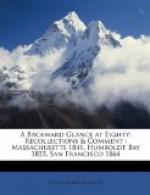It would be hard to find a lovelier view anywhere in the gentle East than is to be gained from the Reservoir Height—a beautifully broken landscape, hill and dale, woodland, distant trees, two converging streams embracing and flowing in a quiet, decorous union beneath the historic bridge, comfortable homes, many of them too simple and dignified to be suspected of being modern, a cluster of steeples rising above the elms in the center of the town, pastures and plowed fields, well-fed Jerseys resting under the oaks, an occasional canoe floating on the gentle stream, genuine old New England homes, painted white, with green blinds, generous wood-piles near at hand, comfortable barns, and blossoming orchards, now and then a luxurious house, showing the architect’s effort to preserve the harmonious—all of these and more, to form a scene of pastoral beauty and with nothing to mar the picture—no uncompromising factories, no blocks of flats, no elevated roads, no glaring signs of Cuban cheroots or Peruna bitters. It is simply an ideal exhibit of all that is most beautiful and attractive in New England scenery and life, and its charm is very great.
Turning to its historic interest, one is reminded of it at every side. Upon a faithful reproduction of the original meeting-house, a tablet informs the visitor that here the first meeting was held that led to national independence. A placard on a quaint old hostelry informs us that it was a tavern in pre-Revolutionary times. Leaving the “common,” around which most New England towns cluster, one soon reaches Monument Street. Following it until houses grow infrequent, one comes to an interesting specimen which seems familiar. A conspicuous sign proclaims it private property and that sightseers are not welcome. It is the “Old Manse” made immortal by the genius of Hawthorne. Near by, an interesting road intersects leading to a river. Soon we descry a granite monument at the famous bridge, and across the bridge “The Minute Man.” The inscription on the monument informs us that here the first British soldier fell. An iron chain incloses a little plot by the side of a stone wall where rest those who met the first armed resistance. Crossing the bridge which spans a dark and sluggish stream one reaches French’s fine statue with Emerson’s noble inscription,—
“By the rude bridge that arched
the flood,
Their flag to April’s
breeze unfurled,
Here once the embattled farmers
stood
And fired the shot heard
round the world.”
No historic spot has a finer setting or an atmosphere so well fitted to calm reflection on a momentous event.
On the way to Concord, if one is so fortunate as to go by trolley, one passes through Lexington and catches a glimpse of its bronze “Minute Man,” more spirited and lifelike in its tense suspended motion than French’s calm and determined farmer-soldier. In the side of a farmhouse near the Concord battle-field—if such an encounter can be called a battle—a shot from a British bullet pierced the wood, and that historic orifice is carefully preserved; a diamond-shaped pane surrounds it. Our friend, Rev. A.W. Jackson, remarked, “I suppose if that house should burn down, the first thing they would try to save would be that bullet-hole.”




